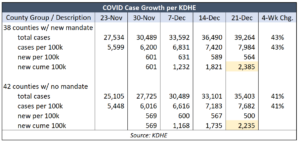Kansans received good news on Tuesday, Dec. 22, 2020, as Kansas Governor Laura Kelly announced the spread of COVID-19 is under control for the first time since May. But data from KDHE refutes her claim crediting it to more counties adopting her latest mask mandate.
“Based on effective reproduction rate,” Kelly said at a news conference. “We know that successful implementation has led to control of the spread of the virus in Kansas for the first time since the stay-at-home order was lifted in May.”
According to Kansas Department of Health and Environment Secretary Dr. Lee Norman, the Rt, or “reproductive factor” of the virus has been trending down in Kansas and has fallen below one. Rt is a key measure of how fast the virus is spreading, it’s the average number of people infected by someone with the virus. Above 1.0 the virus will spread quickly, below that and the virus eventually will stop spreading.
While this news is welcome, Kelly chose to tie it to a policy of mask mandates.
“There is no doubt that this change is also a result of additional counties opting into my administration’s face-covering protocol,” Kelly said.
Her assertion, however, is inconsistent with the data.
Numbers compiled from KDHE’s own reporting show counties with masks mandates experienced more case growth than counties without such requirements. That’s also true of the counties that adopted the governor’s latest mandate in November.
 Over the first four weeks after her new mask mandate was adopted, the 38 counties that adopted the mandate added 2,385 cases per 100,000 of population, going from 5,599 to 7,986 — a 43% increase. But the 42 counties that never adopted a mask mandate experienced lower case growth; they went from 5,448 cases per 100,000 of population to 7,682, adding fewer cases (2,235) and having a smaller case increase (41%).
Over the first four weeks after her new mask mandate was adopted, the 38 counties that adopted the mandate added 2,385 cases per 100,000 of population, going from 5,599 to 7,986 — a 43% increase. But the 42 counties that never adopted a mask mandate experienced lower case growth; they went from 5,448 cases per 100,000 of population to 7,682, adding fewer cases (2,235) and having a smaller case increase (41%).
Governor Kelly offered no justification for her claim, but the available data doesn’t support it.
Great Barrington signer: controlling the virus nearly impossible
Additional information also questions whether slower case growth has anything to do with recent interventions such as a mask mandate.
According to the World Health Organization, case counts worldwide peaked at more than 800,000 on Dec. 20, 2020, and dropped off precipitously with more than 200,000 fewer cases reported on Dec. 22.
Moreover, one of the signatories of the Great Barrington Declaration, Dr. Jay Bhattacharya, says controlling the virus is nigh impossible.
“It’s very, very difficult, maybe even impossible to control the rise in the number of cases in places like Europe, the United States, and the Americas,” he said on a podcast. “The disease is already too widespread.”
Bhattacharya was speaking to Russ Roberts, a libertarian economist formerly of George Mason University and now at the Hoover Institution.
Moreover, Bhattacharya referenced a scientific study in Denmark to explain the difference between protecting people from getting a virus versus slowing its spread.
“There was a study that was just released from Denmark, a randomized study where I think there were about 5,000 people, 2,500 people had masks, randomly assigned, 2,500 didn’t,” he said. “Early in the epidemic when most people in Denmark weren’t wearing masks. And so, it’s a test of whether the masks would protect the wearer, not slow the spread of the disease. And, if you treat that intervention as if it was a vaccine, you’d say it was a 14% efficacy … 2.1% of the non-mask wearers got the disease, 1.8% of the mask wearers got the disease.”
Bhattacharya, who is a professor of medicine at Stanford University and a research associate at the National Bureau of Economic Research and directs Stanford’s Center for Demography and Economics of Health and Aging, said the disease is largely regional, not national.
“I think this is a regional disease,” he said. “So, right now we’re seeing in the Midwest, really, that’s really where the biggest cases are.
“In Italy, in Bergamo, which was sort of the center of this, Lombardy as a whole has seen a rise in cases in the second wave. But Bergamo itself, saw a massive first wave, has not seen a very large rise in cases. It’s one of these things where it hits an area really hard, and it comes back some in that area but it’s going to come back sort of milder the next time.
“And, I think that’s what we’re kind of seeing in the United States. It’s sort of bouncing around the country, and it’s sort of the Midwest’s turn now, unfortunately.”
Kansas Policy Institute president James Franko applauds the mitigation recommendations of the Great Barrington Declaration.
“The Great Barrington Declaration actually treats us like adults by focusing on targeted interventions. It deals seriously with the tradeoffs of COVID policy. Contrastingly, we are living with a one-size-fits-none approach at the federal, state, and local levels, which shows no sign of ending.”
Kansas Policy Institute owns the Sentinel.


